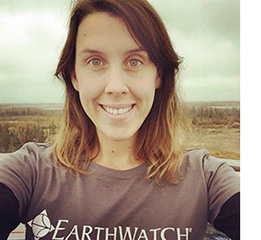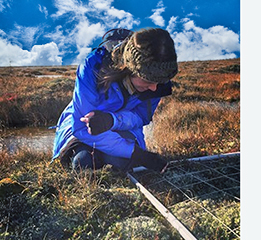.
How an Earthwatch expedition ignited a career in climate science
 For Kaitlyn, the environment was always fascinating. Since she was a kid growing up in the foothills of California's Sierra Nevada Mountains, she'd spent much of her time exploring the natural world. But Kaitlyn had yet to have the opportunity to do hands-on fieldwork, and committing to graduate education in a field she hadn't directly engaged with seemed irresponsible. Kaitlyn "wasn't really sure whether it was going to be worth spending another few years in school, or if (she) should just go and try to get a job."
For Kaitlyn, the environment was always fascinating. Since she was a kid growing up in the foothills of California's Sierra Nevada Mountains, she'd spent much of her time exploring the natural world. But Kaitlyn had yet to have the opportunity to do hands-on fieldwork, and committing to graduate education in a field she hadn't directly engaged with seemed irresponsible. Kaitlyn "wasn't really sure whether it was going to be worth spending another few years in school, or if (she) should just go and try to get a job."
In this moment of doubt, Kaitlyn's family suggested a field expedition to get real, hands-on experience doing the work she was interested in. After all, the best way to find out if you want to spend your life doing something is to start doing it. Her mom assembled a list of pamphlets and research opportunities for her to choose from, but as soon as Kaitlyn saw the description for Earthwatch's Climate Change at the Arctic's Edge expedition, it was "love at first sight."
.
I was so excited from the moment I saw the expedition. And I was like, Okay, that's it. I'm going. It was love at first sight.
.
.
Journey to the Arctic's edge
 A few months later, Kaitlyn was on a three-day train ride to Churchill, a tiny town nestled into the northern stretches of Manitoba's arctic coast. Churchill’s most famous inhabitants are its some 57,000 beluga whales and 1,000 polar bears, but Kaitlyn wasn’t just there for them. Churchill is on the front line of the climate crisis; it has warmed by two degrees Celsius since record-keeping began in the 1880s. This warming has resulted in a myriad of ecological changes, such as shrinking polar sea ice, retreating glaciers, and less snowpack that melts earlier.
A few months later, Kaitlyn was on a three-day train ride to Churchill, a tiny town nestled into the northern stretches of Manitoba's arctic coast. Churchill’s most famous inhabitants are its some 57,000 beluga whales and 1,000 polar bears, but Kaitlyn wasn’t just there for them. Churchill is on the front line of the climate crisis; it has warmed by two degrees Celsius since record-keeping began in the 1880s. This warming has resulted in a myriad of ecological changes, such as shrinking polar sea ice, retreating glaciers, and less snowpack that melts earlier.
After instruction from Earthwatch scientist Dr. Steve Mamet, she immersed herself in climate research. Between workdays in the field measuring permafrost and monitoring the health of the Arctic tree line by examining tree cores, she engaged with fellow participants and field staff, building lifelong relationships and learning about what a career in climatology really looks like. Kaitlyn's Earthwatch experience "flipped a switch"—it gave her the confidence and understanding of the climate field necessary to become a climatologist. It also reaffirmed her passion for protecting the Arctic from climate change.
.
The expedition was a window into climate science. I learned so much that, on the train ride home, I would journal, and I knew then that I wanted to apply to grad school; I didn't know if I would get in or could afford it. But I knew I wanted to go to grad school, and I really wanted to do something related to climate change.
.
.
Once she was back in California, Kaitlyn got to work. Her application to a master's program in Geography prominently featured her Earthwatch experience, and she was soon off to the University of Nevada, Reno. Kaitlyn excelled in her program, conducting in-depth research on Arctic climate data, attending conferences on Arctic climate change, serving as a Teacher's Assistant for climate classes, and ultimately publishing a thesis on climactic variability in the Arctic system.
Today, she works as a climate scientist for Climate Central's Climate Matters Program, working with thousands of journalists and meteorologists to inform communities about how climate change impacts their weather. Her work helps the program's nationwide media network connect global climate change to local audiences. In the future, Kaitlyn hopes to continue connecting people to climate science.
.
I hope we will turn things around and start making meaningful moves to address climate change. Until that happens, I'm going to keep doing this to help people understand why it's so important. We really need to turn things around. Because there is so much at stake.
.
.
.
.
Sign up for the Earthwatch Newsletter
Be the first to know about new expeditions, stories from the field, and exciting Earthwatch news.
.
.
.